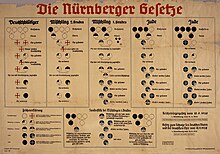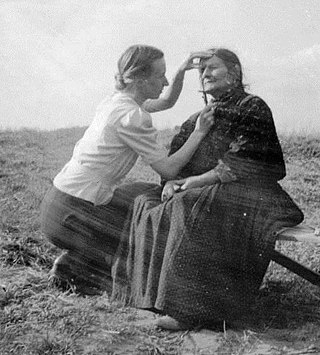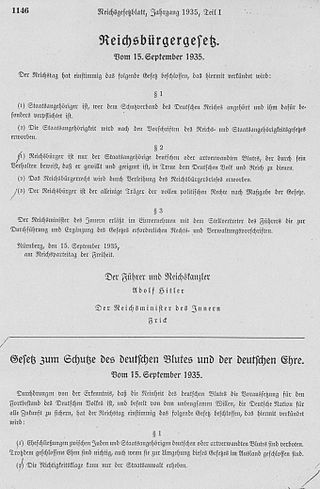Mischling Test refers to the legal test under Nazi Germany's Nuremberg Laws that was applied to determine whether a person was considered a "Jew" or a Mischling (mixed-blood).
Mischling Test refers to the legal test under Nazi Germany's Nuremberg Laws that was applied to determine whether a person was considered a "Jew" or a Mischling (mixed-blood).
On 11 April 1933 the regime promulgated the First Supplementary Decree for the Execution of the Law of Restoration of the Professional Civil Service , colloquially known as the First Racial Definition. This implementing decree stipulated that a person would be regarded as a racial Jew for purposes of the law [1] if he had one Jewish parent or one Jewish grandparent, i.e. if the ancestor was "of the Jewish faith." [2]
Under the law, Jews were to be discharged from the civil service, unless they had been employed since before World War I or unless they had fought on the front lines in the war, or had a father or son who had been killed in the war. [2]
The "one Jewish grandparent" rule was predominant for a period of time in the Third Reich, and had typically been the test incorporated into the Aryan Paragraph, which had been in currency before Hitler's assumption of power on 30 January 1933. However, various social and political factions militated in favor of a new set of discriminatory laws, which were forthcoming at the NSDAP party rally in 1935 in Nuremberg.
The Nuremberg Laws, [3] as originally promulgated in September 1935, used the term "Jew" but did not define the term. The definition of the term was problematic for the Nazis and it was not until the issuance of a supplementary regulation in mid-November 1935 that a legal test that was specific to the Nuremberg laws was formally published.
The original draftsmen of the Nuremberg Laws, puzzled over the problem and pressed for a quick solution, solved it by the simple expedient of limiting the meaning of the term to encompass only "full Jews" (German : Volljuden). This test was relatively easy to state and apply, but Hitler vetoed the idea, without stipulating what he wanted as a replacement.
Meetings among Government and Party officials after the September 1933 annual Nuremberg party rally revealed the existence of two factions:
The resulting compromise was implemented by the First Supplementary Decree. [7] The practical application of "mischling" first and second degree were further elaborated in the Wannsee Conferences and meetings on the "final solution".
The First Supplementary Decree of 14 November 1935 (Decree) addressed this issue by defining three categories: [8]
By applying the test, a person would be classified into exactly one of the preceding categories.
The Decree sets up the legal test defined here.
The first part of the test is implemented by setting up three categories as follows:
The remaining problem was the treatment of a person with two Jewish and two non-Jewish grandparents. This leads to the second part of the test, which has four subdivisions. A person with exactly two Jewish grandparents was deemed a Jew (specifically, a Geltungsjude ) [11] if either:
If such a person is not classified as a Jew under any of these four subtests, then he is a Mischling of the 1st degree (by the terms of Part One).

The following Examples demonstrate how Part Two of the Decree's legal test operates. Remember that in every case, X always has exactly two Jewish grandparents. Unless this initial condition applies, there is no point in applying these tests, as the categorization into the three basic classes (Jew, Mischling, German) is only complicated in the case of "exactly two" Jewish grandparents.

The Wannsee Conference was a meeting of senior government officials of Nazi Germany and Schutzstaffel (SS) leaders, held in the Berlin suburb of Wannsee on 20 January 1942. The purpose of the conference, called by the director of the Reich Security Main Office SS-Obergruppenführer Reinhard Heydrich, was to ensure the co-operation of administrative leaders of various government departments in the implementation of the Final Solution to the Jewish Question, whereby most of the Jews of German-occupied Europe would be deported to occupied Poland and murdered. Conference participants included representatives from several government ministries, including state secretaries from the Foreign Office, the justice, interior, and state ministries, and representatives from the SS. In the course of the meeting, Heydrich outlined how European Jews would be rounded up and sent to extermination camps in the General Government, where they would be killed.

The racial policy of Nazi Germany was a set of policies and laws implemented in Nazi Germany under the dictatorship of Adolf Hitler, based on pseudoscientific and racist doctrines asserting the superiority of the putative "Aryan race", which claimed scientific legitimacy. This was combined with a eugenics program that aimed for "racial hygiene" by compulsory sterilization and extermination of those who they saw as Untermenschen ("sub-humans"), which culminated in the Holocaust.
Mischling was a pejorative legal term which was used in Nazi Germany to denote persons of mixed "Aryan" and non-Aryan, such as Jewish, ancestry as they were classified by the Nuremberg racial laws of 1935. In German, the word has the general denotation of hybrid, mongrel, or half-breed. Outside its use in official Nazi terminology, the term Mischlingskinder was later used to refer to war babies born to non-white soldiers and German mothers in the aftermath of World War II.
"Who is a Jew?" is a basic question about Jewish identity and considerations of Jewish self-identification. The question pertains to ideas about Jewish personhood, which have cultural, ethnic, religious, political, genealogical, and personal dimensions. Orthodox Judaism and Conservative Judaism follow Jewish law (Halakha), deeming people to be Jewish if their mothers are Jewish or if they underwent a halakhic conversion. Reform Judaism and Reconstructionist Judaism accept both matrilineal and patrilineal descent as well as conversion. Karaite Judaism predominantly follows patrilineal descent as well as conversion.
A German Blood Certificate was a document provided by Nazi leader Adolf Hitler to Mischlinge, declaring them deutschblütig. This practice was begun sometime after the Nuremberg Laws of 1935, and allowed exemption from most of Germany's racial laws.

Werner Goldberg was a German of half Jewish ancestry, or Mischling in Nazi terminology, who served briefly as a soldier during World War II. His image appeared in the Berliner Tageblatt as "The Ideal German Soldier", and was later used in recruitment posters and propaganda for the Wehrmacht.
The term Halbjude is a derogatory term for people with a non-Jewish and a Jewish parent. The overwhelming majority of the so-called half-Jews were legally classified as "first-degree Jewish hybrids" during the era of Nazi Germany. Occasionally, the term was used even before the Nazi era. Within Judaism the term half Jew is unusual, since it does not recognize any partial degrees of Judaism; one is either Jewish or not.

Rassenschande or Blutschande was an anti-miscegenation concept in Nazi German racial policy, pertaining to sexual relations between Aryans and non-Aryans. It was put into practice by policies like the Aryan certificate requirement, and later by anti-miscegenation laws such as the Nuremberg Laws, adopted unanimously by the Reichstag on 15 September 1935. Initially, these laws referred predominantly to relations between ethnic Germans and non-Aryans, regardless of citizenship. In the early stages the culprits were targeted informally; later, they were punished systematically and legally.

The Law for the Restoration of the Professional Civil Service, also known as Civil Service Law, Civil Service Restoration Act, and Law to Re-establish the Civil Service, was enacted by the Nazi regime in Germany on 7 April 1933. This law, which followed Adolf Hitler's rise to power by two months and the promulgation of the Enabling Act by two weeks, constituted one of the earliest instances of anti-Semitic and racist legislation in Germany.

The Nuremberg Laws were antisemitic and racist laws that were enacted in Nazi Germany on 15 September 1935, at a special meeting of the Reichstag convened during the annual Nuremberg Rally of the Nazi Party. The two laws were the Law for the Protection of German Blood and German Honour, which forbade marriages and extramarital intercourse between Jews and Germans and the employment of German females under 45 in Jewish households; and the Reich Citizenship Law, which declared that only those of German or related blood were eligible to be Reich citizens. The remainder were classed as state subjects without any citizenship rights. A supplementary decree outlining the definition of who was Jewish was passed on 14 November, and the Reich Citizenship Law officially came into force on that date. The laws were expanded on 26 November 1935 to include Romani and Black people. This supplementary decree defined Romani people as "enemies of the race-based state", the same category as Jews.

Honorary Aryan was a semi-official category and expression used in Nazi Germany to justify the exceptional awarding of Aryan certificates to some regime-favoured Mischlinge who according to Nuremberg Laws standards would not have been recognized as belonging to the Aryan race, but whom German officials nevertheless chose to spare persecution.
Geltungsjude was the term for people who were considered Jews by the first supplementary decree to the Nuremberg Laws from 14 November 1935. The term was not used officially, but was coined because the persons were deemed Jews rather than exactly belonging to any of the categories of the previous Nuremberg Laws. There were three categories of Geltungsjuden: 1. offspring of an intermarriage who belonged to the Jewish community after 1935; 2. offspring of an intermarriage who was married to a Jew after 1935; 3. illegitimate child of a Geltungsjude, born after 1935.

The Ahnenpaß documented the Aryan lineage of people "of German blood" in Nazi Germany. It was one of the forms of the Aryan certificate (Ariernachweis) and issued by the "Reich Association of Marriage Registrars in Germany".

Anti-Jewish legislation in pre-war Nazi Germany comprised several laws that segregated the Jews from German society and restricted Jewish people's political, legal and civil rights. Major legislative initiatives included a series of restrictive laws passed in 1933, the Nuremberg Laws of 1935, and a final wave of legislation preceding Germany's entry into World War II.
An Aryan paragraph was a clause in the statutes of an organisation, corporation, or real estate deed that reserved membership or right of residence solely for members of the "Aryan race" and excluded from such rights any non-Aryans, particularly those of Jewish and Slavic descent. They were an omnipresent aspect of public life in Germany and Austria from 1885 to 1945.
Anti-miscegenation laws are laws that enforce racial segregation at the level of marriage and intimate relationships by criminalizing interracial marriage and sometimes, they also criminalize sex between members of different races.
Bernhard Lösener was a lawyer and Jewish expert in the Reich Ministry of the Interior. He was among the lawyers who helped draft the Nuremberg Laws, among other legislation that deprived German Jews of their rights and ultimately led to their deportation to concentration camps.

The German Citizenship Project was set up in the United States in 2006, and encourages descendants of Germans deprived of their citizenship by Nazi Germany to reclaim German citizenship without losing the citizenship of their home country. It closed its operations in the United States and moved to the United Kingdom where it resumed its activity in 2019 as "German Citizenship Restoration Ltd. (GCR)".

From 1933 to 1945, the Nazi regime ruled Germany and, at times, controlled almost all of Europe. During this time, Nazi Germany shifted from the post-World War I society which characterized the Weimar Republic and introduced an ideology of "biological racism" into the country's legal and justicial systems. The shift from the traditional legal system to the Nazis' ideological mission enabled all of the subsequent acts of the Hitler regime to be performed legally. For this to succeed, the normative judicial system needed to be reworked; judges, lawyers and other civil servants acclimatized themselves to the new Nazi laws and personnel. As of 2021, a few laws from the Nazi era still remain codified in German law.
During the National Socialist era, "Aryan persons" who lived in so-called "mixed marriages" with a "Jewish person" were referred to as "jüdisch versippt". "Jüdisch Versippte" were discriminated against; they were excluded from certain professions and career opportunities, dismissed from public service, and, from 1943, were deemed as "unworthy of military service" and were used for quartered forced labor in "Sonderkommandos" of the Organization Todt.
A person is ... non-Aryan [if] ... descended from non-Aryan, especially Jewish, parents or grandparents. This holds true even if only one parent or grandparent is ... non-Aryan ... [and] especially obtains if one parent or grandparent was of the Jewish faith.See Mendes-Florh p. 642 for the text and for his commentary, in which he also notes that the term "non-Aryan" was the common circumlocution for "Jew" in legal documents until the Nuremberg Laws.
{{cite web}}: CS1 maint: archived copy as title (link)